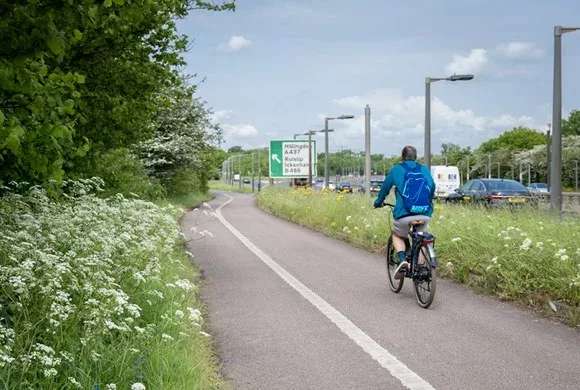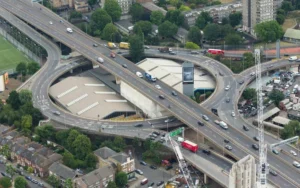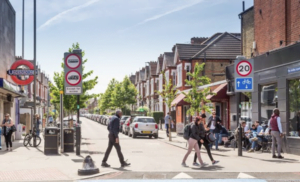TfL has more than doubled the roadside area to be managed as wildflower verges following successful trials, it has reported.
An additional 74,000 square metres of wildflower verges takes the total across London to almost 130,000 square metres, equivalent to 18 football pitches
Wildflower verges encourage biodiversity and help wildflowers thrive, which can lead to greater amounts of carbon being stored in the soil, as well as supporting pollinators such as bees and butterflies
The programme is a key part of TfL’s soon to be published Green Infrastructure and Biodiversity Plan, which sets out how London’s transport authority will seek to respond to the ecological crisis
The project is part of Transport for London’s (TfL’s) continuing work to help encourage biodiversity, mitigate climate change and become more sustainable in its operations.
The new sites were selected following trials across north London, where TfL reduced mowing frequency in order to encourage wildflowers. The flowers create a supply of nectar and other food resources, plus shelter, for wildlife including bees, butterflies, birds and small mammals.
The trial sites, which included Redbridge Roundabout, Rowley Lane roundabout on the A1 and along the A40 in Hillingdon were assessed by TfL’s in-house environmental and asset management teams. TfL is now adding new locations, which will increase the area being managed this way to almost 130,000 square metres – the equivalent of more than 18 football pitches. The new locations include Gants Hill roundabout in Redbridge, Clockhouse roundabout in Feltham and on the A21 Sevenoaks Road (Green Street Green) in Bromley.
Wildflower verges take several years to fully develop and are in bloom for a limited period of the year. TfL will continue to maintain these verges, but mowing will be timed to allow wildflowers to grow, with edges regularly mowed to ensure they remain safe for passing drivers. Signage will also be installed helping to make clear that these areas are being managed to encourage wildflower growth. TfL will be keeping all sites under review and also looking at whether additional sites both on the TfL Road Network, as well as on other green spaces managed by TfL, could be managed this way in the coming years. It will also be liaising with local boroughs to ensure litter picking at these locations is coordinated and monitored, as well as working with local stakeholders to explore opportunities for collaboration to further enhance and promote these sites.
Lilli Matson, Chief Safety Health and Environment Officer at TfL, said: ”We are committed to building a network that is resilient to climate change and promotes biodiversity while being safe and reliable for Londoners. The new wildflower verges will encourage biodiversity and make London a more liveable and nature-rich city. We will continue to work with our partners to adapt our network to reduce the short and long-term impacts of climate change.”
Shirley Rodrigues, Deputy Mayor for Environment and Energy, said: “London can be greener healthier and home to more exciting creatures. To achieve this goal it’s vital that TfL continues its work to double the area in the city covered by wildflower verges.
“Working together we can all help build a better London for everyone – the people and the pollinators that call it home and who benefit from a greener, fairer and more prosperous city.”
The introduction of new wildflower verges forms a key part of TfL’s commitment to enhancing biodiversity across its estate. TfL’s plan will be set out in the forthcoming Green Infrastructure and Biodiversity Plan. The plan intends to provide clear information on TfL’s approach to protecting, connecting and enhancing biodiversity and how TfL will work with other organisations to tackle this vital issue both now as well as part of longer-term planning.
As well as increasing biodiversity on roadside verges, TfL is also working to implement new Sustainable Drainage Systems (SuDS) across London, with a particular focus on SuDS that include green infrastructure, such as rain gardens. The Mayor’s Transport Strategy includes a target to deliver an effective surface area of 50,000 square metres to first drain into SuDS features rather than conventional drains and sewers. TfL is committing to delivering 5,000 square metres of catchment a year along its road network as part of this target. Given the scale of the climate crisis and the need to install SuDS across the whole city, TfL believes that SuDS should be considered as a default design feature for any project that involves excavation or structural changes to a roof. TfL designers will now be required to fully justify any instances where SuDS have not been included.
TfL’s recently published Business Plan has allocated up to £2m per year of funding to improve understanding of the impacts of climate change and to develop and deliver plans to adapt to it. This is in addition to the £4m Green and Healthy Streets Fund provided by the Mayor to deliver sustainable drainage on both TfL’s roads and those managed by the boroughs. With the right capital investment, TfL believes that it can accelerate the Mayor’s and TfL’s ambitious plans and become a net zero-carbon city by 2030.
For more information on how TfL is maintaining its green spaces, and adapting to climate change, please visit https://tfl.gov.uk/corporate/about-tfl/green-infrastructure





















